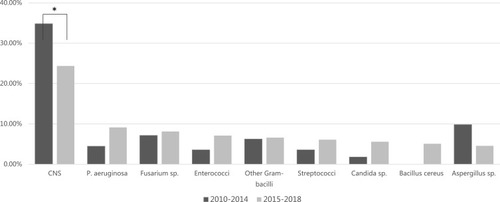Figures & data
Table 1 Clinical Characteristics of Patients by Endophthalmitis Etiology in Zhongshan Ophthalmic Center
Table 2 Genus Distribution of Pathogens Isolated from Endophthalmitis Patients by Clinical Setting
Figure 1 Time trend of pathogens most frequently associated with infectious endophthalmitis in Zhongshan Ophthalmic Center. To evaluate the temporal trend in the distribution of pathogens, data were divided into two periods: 2010–2014 and 2015–2018. Chi-square analysis revealed a significant change in the percentage of pathogens between these two periods (χ2=200.833, P=0.004). Post hoc analysis revealed that the percentage of CNS decreased significantly from 34.82% in 2010–2014 to 24.37% in 2015–2018 (P<0.001). *P<0.01.
Abbreviations: CNS, coagulase-negative staphylococci; P, Pseudomonas.

Table 3 Overall Susceptibility Rates of Isolated Bacteria to Different Antibiotics in Zhongshan Ophthalmic Center
Figure 2 Time trend of overall antibiotic susceptibility rate from 2010 to 2018 in Zhongshan Ophthalmic Center. Some antibiotics were omitted as the numbers of isolates that underwent susceptibility testing were not comparable between periods. The overall susceptibility rate for tobramycin decreased significantly from 82.61% in 2010–2014 to 56.34% in 2015–2018 (P=0.001). Similarly, cefazolin decreased from 76.60% to 12.20% (P<0.000), cefuroxime sodium from 70.21% to 44.59% (P=0.006), and methicillin/oxacillin from 78.26% to 33.93% (P<0.000).
Notes: *P<0.01. #Bacteria isolates were sensitive to either methicillin or oxacillin.

Table 4 Pathogen Spectrum of Endophthalmitis Patients Who Underwent Evisceration/Enucleation
